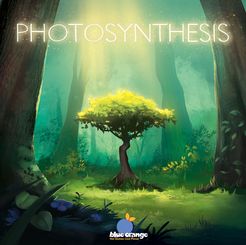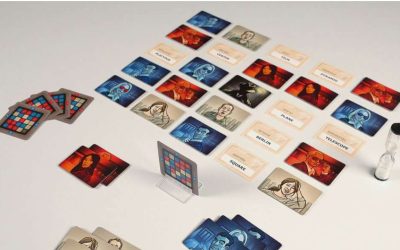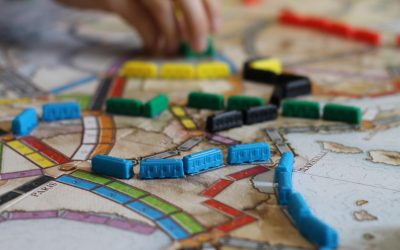Introduction to Euro Games

Throughout the second half of the 20th Century, most popular board games around were of American origin…
Growing up as a kid in Germany, I spent most of my spare time playing games like Monopoly, Risk or Sorry! with my friends. To this day, the majority of people asked would probably name these titles on the top of their list of games they might have heard of or even played. Even though these games were extremely popular, they had a few things in common that made them problematic as far as the gaming experience went:
A lot of them used the concept of player elimination as the ultimate goal. In Risk, for example, the last player standing won the game. In Monopoly the last player not being bankrupted was declared the winner. Furthermore, they relied heavily on luck. In Monopoly and Sorry you roll dice which determine the outcome of your turn. There really wasn’t much strategy or planning that would give you an advantage. Your success depended directly on the outcome of your roll. In addition, they also thrived on conflict between players. Risk would be the most obvious example here, but many other games of that era come to mind. I mean, Sorry! Is pretty much a series of sending your fellow players back to the start if possible. And lastly, they would not allow a lot of room for player interaction. On anyone’s turn they did their move while the other players watched without any chance to prevent or influence the game in any meaningful way. As a result, we romanticize many of these games because we fondly remember them as a part of our childhood, but we don’t really think of ‘loving’ them as far as the gaming experience was concerned. Speaking for myself, I remember countless games of Monopoly and Risk that I spent on the couch after being eliminated, while I was waiting for my friends to finish the game without me.
Throughout the 1980’s game designers, primarily out of Germany, decided to change the landscape of the board gaming experience. New games were published that offered fresh and exciting ideas, many of which strived to break the mold of the traditional mechanics. In Germany, and many parts of Europe, games like ‘Labyrinth’, ’Enchanted Forest’ and ‘Scotland Yard’ became widely popular and an industry emerged that introduced more and more original titles each year. At the time most of these games were only available in Europe. This changed in the late 1990’s when a game called ‘Settlers of Catan’ appeared. ‘Catan’ (which is its current name) became and runaway success in Europe and beyond and eventually made its way into the North America market. Other internationally successful titles followed, including ‘Carcassonne’, ‘Ticket to Ride’ and ‘Dominion.’
Today we call these games Eurogames. This category title is not only describing its origin, but also specific game mechanics that sets it apart from the traditional American style games. Even though many differ in design and style, most Eurogames share a basic set of similar characteristics: First and foremost, players are never eliminated from the game. Everyone remains involved until the end. Conflict is usually minimized and indirect. Winning a game is a function of collecting victory points or sets of resources. In addition, there are often multiple viable paths to scoring points or securing a winning position. Eurogames also encourage, and often require, extensive player interaction. Every player is frequently involved, even when it is not their turn. This can be either through trading, negotiating or other forms of influence. Furthermore, Eurogames use very little randomness or luck. If there is an element of randomness, it allows the player to make a reactive decision after the fact rather than before. Dice are rare in Eurogames, although not unheard of.
Taking all of these mechanics in account, most Eurogames provide a more socially satisfying gaming experience than their American counterparts. They offer players the chance to interact with other people around the table in a more meaningful way and allow room for planning and strategizing without any direct aggression or conflict.
If you have not tried a Eurogame before, I strongly encourage you to bring one to the table with your friends or family. The list of great must-try titles is endless. Here are some of my favourite games that are less well known than the above mentioned ‘modern classics.’ Happy gaming!
2-4 players, ages 10 and up
The sun shines brightly on the canopy of the forest, and the trees use this wonderful energy to grow and develop their beautiful foliage. Sow your crops wisely and the shadows of your growing trees could slow your opponents down, but don’t forget that the sun revolves around the forest. On their turn a player receives points based on their trees that are facing the sun. They can use these points to grow or expand their forests, trying to block other player’s trees in the process by creating shade. Visually beautiful components and game play that is very strategic yet easy to learn.
2-6 players, ages 8 and up
Each player wants to move their pawn over a system of bridge-like planks to the other side of the board. An easy task! Or at least it would be if everyone were working together, but alas you’re not. Instead you’re all working on your own right next to one another, each convinced that your way is best.
In game terms, players simultaneously select five action cards to be performed from the nine actions available and lay them down in order they are to be played. The turn is then resolved one card at a time. The actions allow players to place plank foundations, place planks, move their pawns, cancel other players’ actions, or remove planks or foundation stones. As can be expected for a design with simultaneous action selection, the game is rather chaotic.
2-6 players, ages 8 and up
In this charming tile-laying game, players are acquiring buildings to be placed within their Alhambra complex. On a player’s turn, a player may 1) take money from the open money market, 2) purchase a building from the building market and either place it in his Alhambra or reserve, or 3) engage in construction and re-construction projects with buildings that have been placed in the player’s Alhambra or reserve. The game rewards efficiency, as when a player purchases a building from the market for the exact amount of money, the player may take another turn. Players with the most buildings in each of the six building types in his Alhambra score in each of the scoring phases, and points are awarded for players’ longest external “wall” section within their complex. After the 3rd scoring phase, the player with the highest score wins.
2-4 players, ages 10 an up
A beautiful and entry level tile laying game reminiscent of ‘Carcassonne.’. You have to play tile pieces to create an exotic island with beaches and tropical forests.
Game play involves placing tiles to enlarge the exotic paradise step by step. Use the sun discs to try to block the other players.
The player who enlarges areas skillfully and is able to close as many areas as possible attracting blue pelicans has the best chances of winning.
2-4 players, ages 10 and up
Mallorca, Island of the Wind. A place of golden beaches and a light-blue sea. The almond harvest is at hand, in addition, juicy oranges, lemons, and figs are ready to be picked and taken to the market. Olive trees bewitch the country with their curled branches and sumptuous vineyards invite passers-by to walk among their warm earth. In the midst of this landscape, your centuries-old natural stone farmhouse provides a home and supports your large windmill.
Listen to the wind, which propels your windmill! Then take in the course of the yearly harvest the sweetest and most valuable fruits from the land. Load them on your old donkey cart and travel around the island, selling them everywhere. If you manage this quickly, you will soon be the richest farmer on the island.
Are you intrigued to try a Euro game? Here are my top suggestions:
‘Spiel Des Jahres’ Winners 2021
Arguably the most important event with regards to the world of board gaming is ‘Das Spiel,’...a fair that is held each October in the German city of Essen. Exhibitors and guests from all around the world gather for 4 days to present and try all of the new and exciting...
Word Guessing Games
The philosopher Friedrich Nietzsche once said:...“All I need is a sheet of paper and something to write with, and then I can turn the world upside down.” Even though I am almost certain that he did not say this with regards to board games, part of me wonders and...
The History of ‘Ticket to Ride’
What defines a great board game?...It is its theme, the accessibility and elegance of the rules, the design and production of the components, the depth of strategy, or the level of enjoyment one experiences when playing it? I believe it is a combination of all of...







